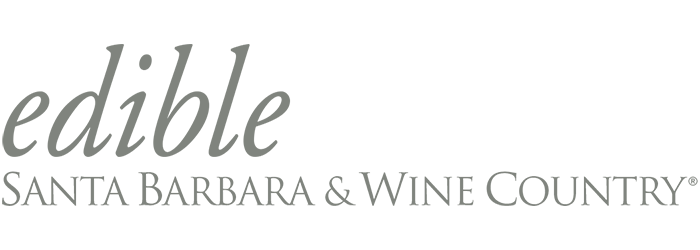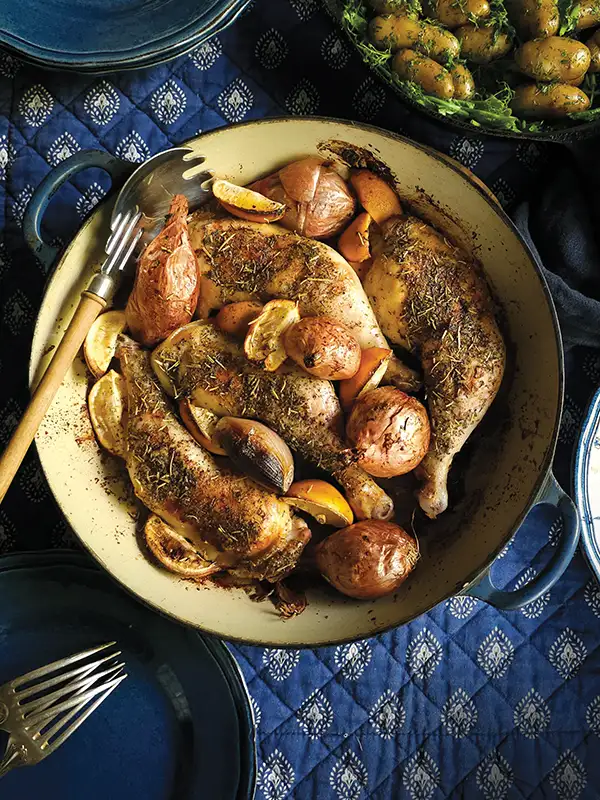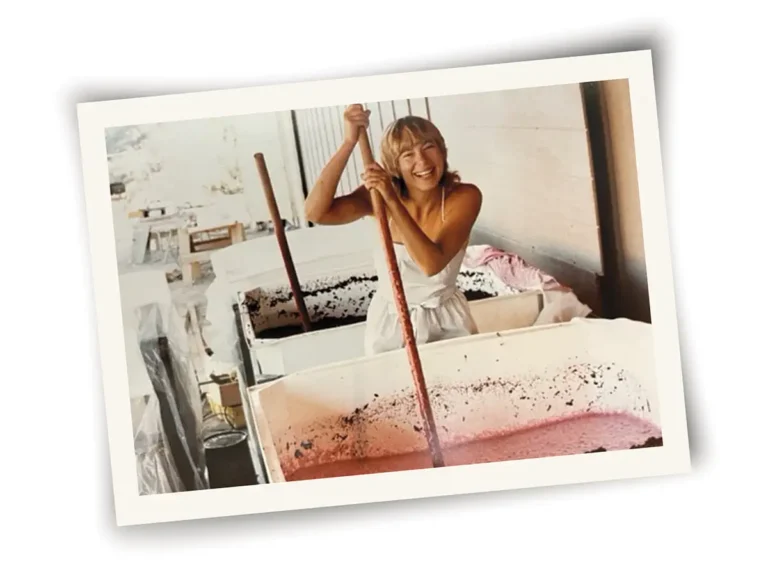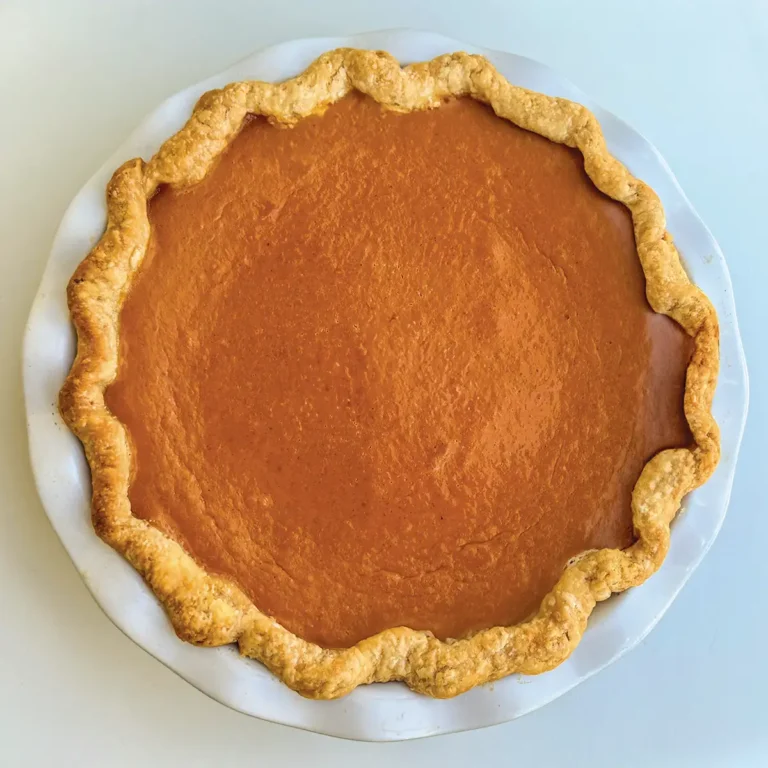Bubbles, Handcrafted: A Sparkling Tradition Takes Root in Santa Barbara County

Sparkling wine may have its historic roots in the Champagne region of France, but in Santa Barbara County, it’s taken on a life—and a sparkle—of its own. What began with a handful of winemakers experimenting with méthode champenoise has grown into a full-blown movement: Today, more than 85 producers across the county are bottling bubbles, from traditional cuvées to funky Pét-Nats and prosecco-style wines made for easy, joyful drinking. See the Santa Barbara’s Sparkling Wine Guide on page 34 for locations throughout the county.
It’s a movement born not just of trends but of intention. In a place where slow food and small-batch production are part of our culture, it makes sense that winemakers approach sparkling wine with care and tradition, while also testing boundaries and rewriting the rules. Here, Pét-Nats (Pétillant Naturel style) are gaining popularity—bottled during primary fermentation, they’re cloudy, funky and wild, often with crown caps like a beer bottle. Rosé sparkling wines are everywhere, bringing vibrant berry flavors and a more relaxed, summery vibe. Some wineries even make sparkling reds or experiment with unexpected grapes like Albariño or Grenache Blanc.
Sparkling Wine is Rooted in the Vineyard
Like all wine, sparkling wine starts in the vineyard. In Santa Barbara County, that means cool coastal breezes, foggy mornings and long growing seasons—ideal for cultivating high-acid grapes like Chardonnay, Pinot Noir and Pinot Meunier. Grapes for sparkling wine are typically picked earlier than those destined for still wine, preserving brightness and acidity. Many local vineyards are picked by hand in August or early September, often in the early morning hours, followed by a toast among pickers and winemakers.
Bubbly Beginnings

The first sparkling wines in Santa Barbara County included single bottlings from Sanford, Brewer-Clifton, Kalyra and Lucas & Lewellen. Then Norm Yost of Flying Goat Cellars launched Goat Bubbles in 2005 as the region’s first program of méthode champenoise, fully in-house sparkling wine—hand-riddled, disgorged, waxed and labeled with love.
Later producers have built new sparkling traditions and rituals from the ground up. Each bottle carries not just bubbles, but a story about a family, a place or a dream. At Riverbench, winemaker Clarissa Nagy and team have elevated sparkling into its core identity, releasing the county’s first sparkling Pinot Meunier alongside a lineup of eight traditional-method styles made from estate fruit, grown sustainably since 2008. In the Sta. Rita Hills, Flying Goat, Sanford, Fess Parker and others continue to lean into Champagne’s traditions. Newer producers are adding their own vibrant expressions to the mix, showing that bubbles can come from unexpected grapes and bold ideas.
Family-Driven Sparkling Wine from Fess Parker
In 2015, the Fess Parker family launched their small-batch sparkling label, Fesstivity, built around Chardonnay and Pinot Noir, and their first Blanc de Blancs and Brut Rosé. But the story goes back much further. Founded in 1989 by actor-turned-winemaker Fess Parker—famous for his roles as Davy Crockett and Daniel Boone—the winery began with an estate vineyard in the Foxen Canyon area of the Santa Ynez Valley, crafting Rhône and Burgundian wines.
Ashley Parker Snider, daughter of Fess, says it was her mom, Marcella, who had a love for Champagne. “She was one of those very classy ladies of the time, a bit of a diva, but more subtle,” Ashley remembers. “And she always knew what she wanted.”
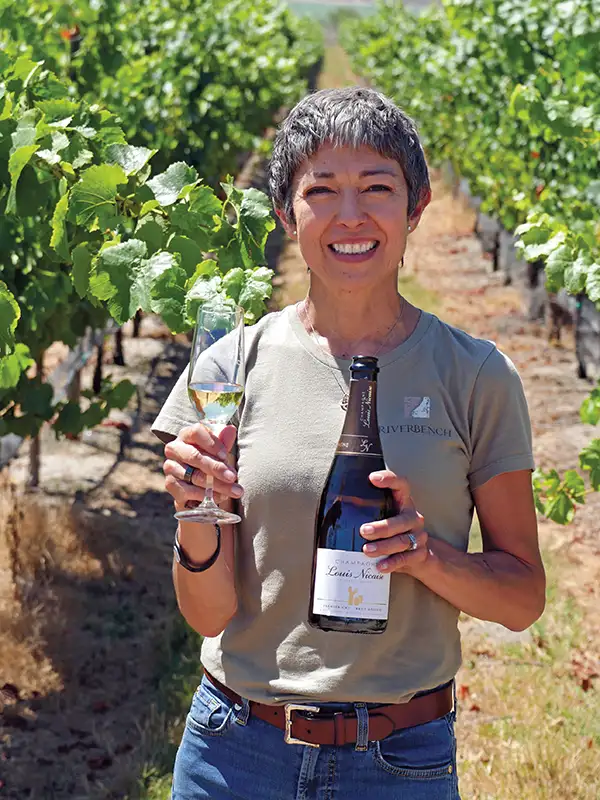
Marcella was a singer in Colorado, then Los Angeles, where she met Fess. As they created a family and a winery together, she maintained a Less Is More mantra, emphasizing discipline and creating things that last. But she was also all about celebrating life’s moments, big and small. It was Marcella who nurtured Ashley’s love for wine, encouraging a legacy of working hard and building the Parker family business.
In 2008, the Parker West vineyard was planted in the Sta. Rita Hills with southern exposure and just 11 miles from the cold Pacific Ocean. As this vineyard matured, they identified it as the ideal source of Chardonnay and Pinot Noir for sparkling wine. Ashley and her brother Eli decided to launch their sparkling wine program, naming it after the elegant, celebratory style their mother embodied: Fesstivity.
“The whole idea of bubbles was a nod to my mom,” Ashley says. “It’s a way to celebrate all of life’s little things and to come together.”
She explains that the traditional method is a complicated process, and the juice has to be touched about 20 times before it gets into people’s hands. It’s clear this whole ritual continues to honor Marcella. “We do everything we can to keep the price non-ridiculous, so people can afford to get it in their glasses. And enjoy it.”
The Parkers keep Marcella’s and the family’s tradition going and celebrate family with bottles of sparkling put away the year new members are born.
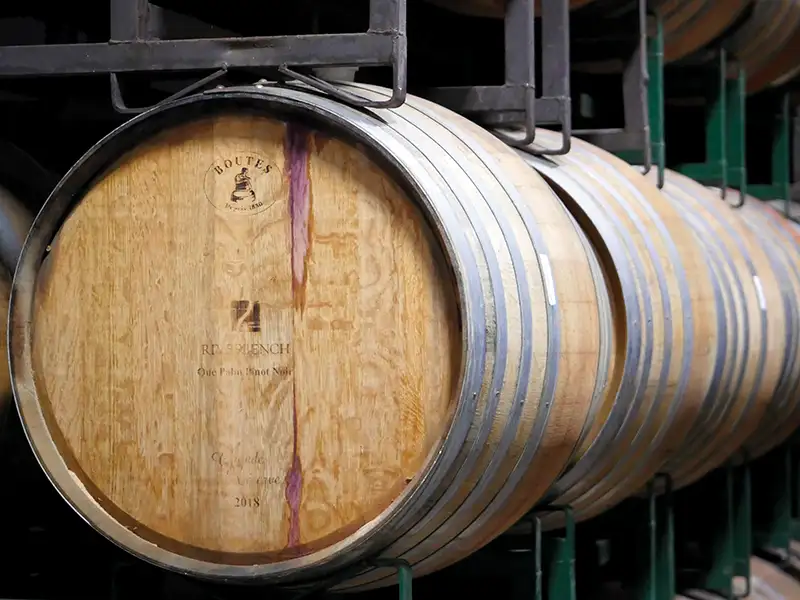
“We celebrate everything with bubbles,” Ashley says. “Sparkling is just the right thing to do.” Of course, weddings, holidays, and the usual events, but also when friends need comforting, and hard times need some soothing.
Every wine at Fess Parker is made in-house using the méthode champenoise, with extended bottle aging en tirage for added texture and complexity. Their small-production Blanc de Blancs, Blanc de Noirs, Brut Rosé and Brut Cuvée, sourced from Sta. Rita Hills estate vineyards, echo the sophistication of Champagne with a Central Coast soul.
Their inaugural 2018 vintage of Fesstivity’s “Anniversary Cuvée” was released in honor of Fess Parker Winery’s 30th anniversary and marked their 35th year as a family-owned-and-operated winery.
Bubbles for Everyday Celebration
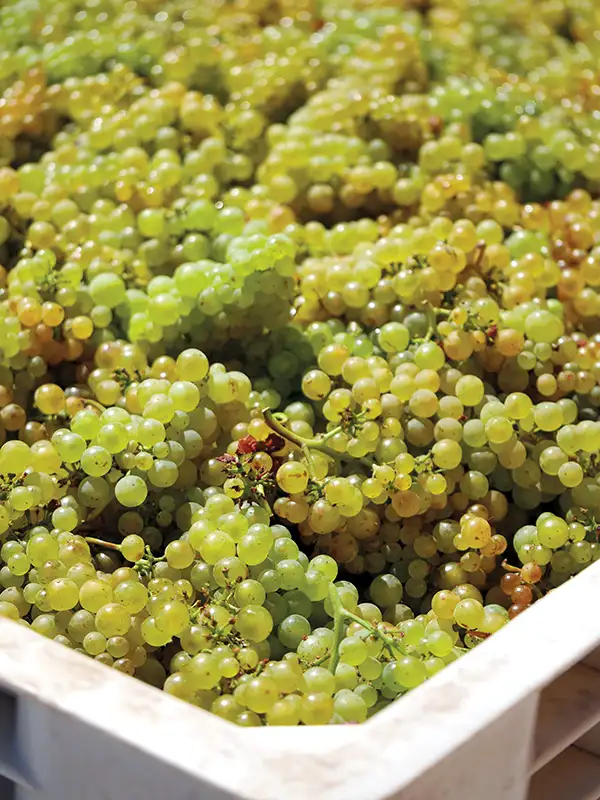
Once reserved for coronations, weddings and life’s biggest milestones, sparkling wine is now cherished as an everyday luxury. Here especially, we are lucky to have so many local quality wines just minutes from us, no matter where we are in the county. And with so many sparkling wines, bubbles are frequently part of casual meals and backyard hangouts.
Sparkling wine pairs with everything from oysters and fried chicken to popcorn—as well as tamales to Santa Maria–style BBQ. And don’t forget dessert! It’s the easiest pairing wine for food, events, friends and well, anything.
Santa Maria Roots at Riverbench Vineyard & Winery
Deep in the Santa Maria Valley—the oldest American Viticultural Area in Santa Barbara County—a vineyard was established in 1973 on the Santa Maria Bench, growing Chardonnay and Pinot Noir in the cool climate of coastal winds from the Pacific. It wasn’t until 2005, when the Hamils, the Hermrecks and the Willses—three long-time Santa Maria families—bought the property, that they started producing their own wines.
As winery production grew, they knew they had something special. Dedicated to sustainable winegrowing, they aimed to craft excellent wine, protect the environment, conserve natural resources, ensure the long-term health of the vineyard and support the well-being of their team. They already had a successful history growing two of the traditional Champagne grapes, so they began educating themselves in French sparkling wine traditions alongside sustainability practices.
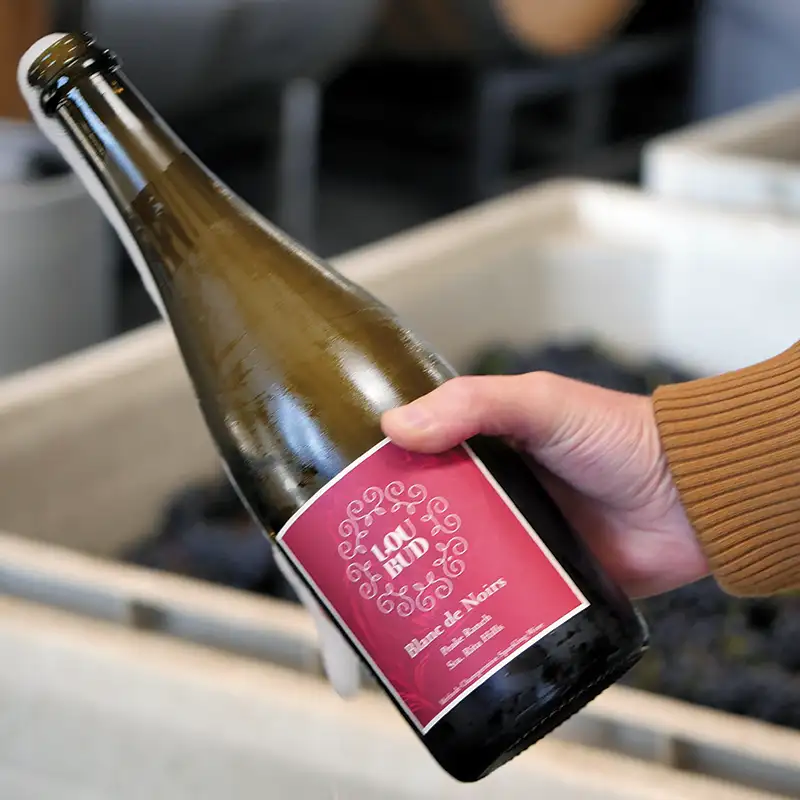
Winemaker Clarissa Nagy came on board in 2012, bringing her love of Santa Maria Valley (SMV) terroir, years of experience in the area and elegant winemaking approach. It was here that she fell in love with the land and the acidity of Pinot Noir (as well as a fellow winemaker at Byron who would become her husband).
Clarissa worked with many clones of Pinot Noir in her time there, coming to love their silky tannins in SMV, and she was excited to see this play into sparkling wine. As she worked with Riverbench’s mentor (a fifth-generation winemaker from Champagne), she decided that her first vintage, 2014, would be made all on her own, bottled under her own label.
The wine is delicate. You have to talk to it sweetly and give the yeast a little pep talk.
“I wanted to be sure I wouldn’t blow it!” she says. “And it turned out great.”
Since then, production has grown into a lineup including Blanc de Blancs, Blanc de Noirs, Brut Rosé, Extra Brut, Demi-Sec and the signature Cork Jumper Cuvée—a blend of Chardonnay, Pinot Noir and Pinot Meunier. In 2017, Riverbench made history as the first in the county to release a sparkling Pinot Meunier as a stand-alone bottling.
“We bring in the Pinot Meunier first, shortly after is Wente Chardonnay,” Clarissa explains. “This year, everything is about two weeks ahead of last year, and the Pinot Noir is a little ways out still.” She is hands-on in the vineyard and in the winery, as she plans and oversees the tasks for harvest and fermentation.
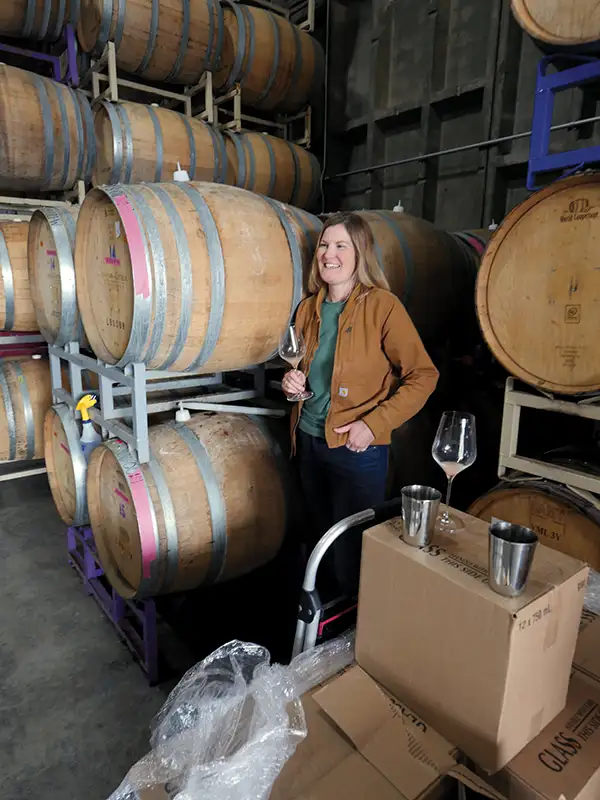
“For sparkling wine, everything you know from still winemaking, you throw out,” she says. “Thankfully, I am used to acid. Because of being in an ancient riverbed, we have very well-drained soils and fantastic acidity. The vines hold acidity, which works very well for sparkling. The lab numbers come out exactly like in Champagne.”
With sparkling wine, whatever is in the base wine is going to get accentuated through the process. So, Clarissa tries to be very light-handed in the cellar, looking for ways to support and enhance the grapes. “The wine is delicate. You have to talk to it sweetly and give the yeast a little pep talk,” she says. It’s much like parenting or being a good friend. “I tell the grapes, ‘You can do it!'”
In 2015, Riverbench added the third grape variety famous in Champagne, Pinot Meunier, to the vineyard. “This is because the families are so amazing to work with,” Clarissa says. “They let me plant an acre.” Clarissa had attended La Fête du Champagne and realized that most of her favorite cuvées included Pinot Meunier. “I love that they are open to new ideas and trust me to try new things. I’m very thankful.”
Riverbench was the first to plant Pinot Meunier in Santa Barbara County, and it was a hit. They also make a carbonic Pinot Meunier. The sparkling wine flights began featuring the first Santa Barbara sparkling Pinot Meunier in 2019.
Clarissa’s goal is always to enhance and show what she tastes in the vineyard. She encourages the grapes and wines to be their best with a delicate touch, then brings that experience to people in the glass. Clarissa always barrel-ferments in neutral barrels to add a creamy elegance and nuance to the wine, and lays the bottles on the lees for about a year and a half—their sweet spot for all sparklers.

Another ritual for Clarissa is to toast each new vintage with a bottle of Grower-Producer Champagne for the first grapes. She selects one with ties to folks she has met in Champagne, pops it open in the vineyard, says thank you, and toasts the grapes. “Time to celebrate the new vintage!”
And Clarissa’s favorite? “I prefer the Blanc de Blancs; it’s great for food pairing,” she says. “I love to cook and pair food with wine—oysters and triple-cream brie are some of my favorites.”
The family owners have evolved, as the Goodwins took over from the Hermrecks. And Riverbench continues to push the quality forward with estate-grown, méthode champenoise sparklers and regenerative farming practices. The holidays are particularly festive, as celebrations include their pretty glittering bottles (great for gifts). Watch for glitter bottle classes this fall in Santa Maria’s Foxen Canyon and Santa Barbara’s Funk Zone.
Sparkling Wines Further West
The most grapes for sparkling wine are found in the Sta. Rita Hills AVA, where Flying Goat and Sanford have been making high-quality bubbles, among many others. This area is also known for Chardonnay and Pinot Noir, where cool weather, fog from the ocean and long growing season all contribute to their excellence.
Younger winemakers can source fruit from some of these Champagne-like vineyards, adding traditional or modern, fun sparkling wines to their lineup when they don’t have an estate.
Loubud Wines in Downtown Santa Barbara
One of the youngest sparkling winemakers focusing on her own label of bubbles is Laura Hughes of Loubud Wines, founded in 2015. Named after a nickname given to her by her father when she was young, Loubud has exploded onto the sparkling scene.
Hughes brings an artistic, micro-production approach to sparkling wine, crafting vineyard-designated bottlings from cool-climate sites like Cebada Vineyard. Each wine reflects her focus on precision and place, offering sippers a glimpse into small-lot winemaking. In her intimate El Paseo tasting room, you can settle in for a truly personal experience—sipping elegant sparkling wines while working on hand-cut puzzles with Hughes or her husband, Paul, (and their dog, Taco).

As Laura prepares Pinot Noir from El Jabali vineyard to be pressed, she muses on the process: “Traditional method is an art form that has some inscription to follow. You stay the course, like a recipe, but use your own sensibilities to follow a style. It’s very ritualistic.”
One particular ritual she uses for sparkling wine is barrel fermenting. She ferments in neutral barrels instead of stainless steel. “The oak complements the acidity, and softens it a bit, making it less rigid,” Laura says. This is just one stylistic preference Laura follows, which is rooted in the heritage of Schramsberg in Napa, where she started her bubbly path. “More citrus comes out in the flavors, instead of tropical.”
Laura also blesses the first pick of each vintage with a little spray of her favorite Loubud Sparkling Wine, as well as a drink and donuts, plus a toast to the harvest. “I love this ‘cheers!’ before harvest, for our safety and our sanity,” she says. “We’re doing this because we love it. Long days are coming, so we bless the fruit, show thanks to Mother Nature.”
Sparkling wine became Laura’s focus in 2012. After starting work at Sanford, she convinced the team to try this experiment, when there weren’t many bubbles in the area. Laura used her experience at Schramsberg (plus harvests in Burgundy and South Africa) to help create the sparkling program there, and launch her own brand.

Loubud’s first vintage was in 2015 (so this is their 10th anniversary), starting with a Blanc de Noir and a still rosé. “Those first wines were from Cebada. They are really sandy soils in SRH [Sta. Rita Hills], and have a lovely natural acidity. Vines struggle a little more in this soil, so the flavors are more concentrated in the fruit.”
This is why the Blanc de Noir will always be Laura’s favorite—the first wine she ever made all on her own. And this Pinot Noir is in one of the most beautiful spots in the world, overlooking the ocean. After convincing herself she could do it, and experimenting with some of the best fruit, she has landed on crafting extra brut, SRH sparkling wines, some aged 1 1/2 years on the lees, some for two or more years (for reserve bubbles). Now, she wants to share them with everyone.
The tasting room opened in December 2024, just one month after the birth of the couple’s first child. It’s small and cozy, set in a typically Santa Barbara picturesque courtyard just off State Street. Husband Paul Hughes is also a handcrafting artisan, with hand-cut wooden puzzles. He draws images, loves puzzles and started creating his own, cutting one piece at a time. Some are inspired by vintage magazines, others from local art around Santa Barbara.
Laura is convinced about the terroir here. “There is so much significance in the land at Sanford and in the Sta. Rita Hills: love, passion, excitement. Many people working there have been with the land since the original planting. I see lots of creativity and entrepreneurial spirit here; it’s very inspiring. SRH isn’t known for traditional-method sparkling wine yet, but it will be!”

